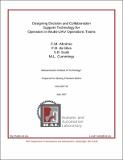Designing Decision and Collaboration Support Technology for Operators in Multi-UAV Operations Teams
Author(s)
Scott, S. D.; Cummings, M. L.; Almirao, F. M.; da Silva, F. B.
DownloadHAL2007-02.pdf (3.480Mb)
Other Contributors
Massachusetts Institute of Technology. Dept. of Aeronautics and Astronautics. Humans and Automation Laboratory
Metadata
Show full item recordAbstract
Effective team collaboration and timely decision-making significantly influence the outcome of
time-sensitive military operations. The increasing complexity introduced by the recent move
towards network centric operations (NCO) in U.S. military operations provides additional
challenges for efficient decision-making. Future operations will include co-located and
distributed teams composed of operators from difference services, often at different global
locations. Military operations which require extremely quick decisions, such as operations
dealing with time-sensitive targets (TST) like improvised explosive devices (IEDs), are
particularly challenging in NCO teaming environments. Operators in TST environments not
only have to manage overwhelming amounts of target-related information, but also have the
overhead of communicating and coordinating with co-located and distributed team members.
Given the increasing trend for modern hostile forces to employ unconventional weapons such as
IEDs and suicide bombs, the success of TST operations are becoming critical to current and
future military operations. Providing TST teams with effective tools for communicating and
coordinating their efforts is key to enabling their success.
Date issued
2007Publisher
MIT Humans and Automation Laboratory
Series/Report no.
HAL Reports;HAL2007-02